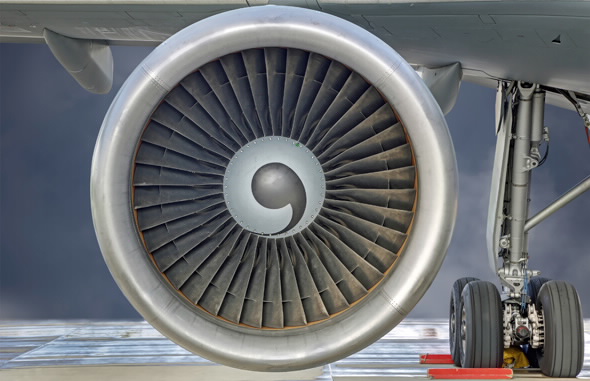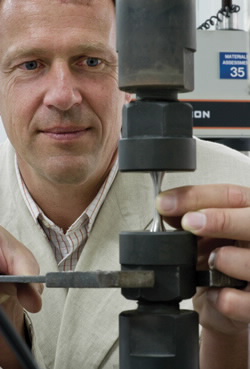The melding of disciplines and advances in methods of analysis using neutron and synchrotron X-ray diffraction are revealing the most complete picture of metals under complex conditions—according to Bragg Institute senior researcher and project leader, Klaus-Dieter Liss.
 |
Insights from applying these methods are leading to the development of materials that are strong, durable, easily-shaped, easy-to-use and, importantly, can withstand extreme conditions. Metals that can retain their performance when subject to high temperature, pressure, shock and load, are important in the automotive, aerospace, nuclear, biomedical and smart device industries.
Liss leads a multi-disciplinary team at the Bragg Institute with qualifications and expertise in physics, instrumentation, mechanical engineering and materials science, who are investigating microstructures in metals, that is, all aspects of the arrangement of atoms and the mechanisms that occur at that level. He is also a member of the advanced diffraction and scattering beamline proposal group at the ANSTO-operated Australian Synchrotron in Melbourne. An expert group at ANSTO’s Institute of Materials Engineering collaborates on many projects.
Recently Liss was invited to present an overview of the team’s work carried out over the last 10 years in two sessions at the prestigious meeting of the Minerals, Metals and Materials Society (TMS) held in the US. The meeting brought together more than 4,000 business leaders, engineers, scientists and other professionals in the materials field.
There is considerable international interest in this approach, said Liss. “It allows you to bridge distances and scales—from bulk to nanostructure,” said Liss.
“Because X-rays and neutrons can gather real-time, time-dependent and in situ data of metals under extreme temperatures and during plastic deformation, you see more than in the lab,” said Liss. The fact that they can take measurements in situ gives the investigations a distinct advantage.
In contrast to conventional characterisation methods to process a sample, quench it, cut it, study the cut and start over with new parameters, neutron powder diffraction and real-time synchrotron high energy X-ray crystallography provide complementary, comprehensive thermomechanical information.
A closer look at the science of neutron and X-ray diffraction techniques
 |
| Klaus-Dieter Liss |
“We can determine the detailed structure of metals in the crystalline, amorphous and liquid states at high temperature, under high pressure, and during deformation,” said Liss.
Temperature, pressure and applied fields can affect a material’s properties because they cause changes to the atomic structure. Their work on deformation extends to thermomechanical processing, stress induced effects, refinement, grain rotation, slip, twinning and martensitic transformation systems in single and multiphase metals.
In a series of collaborations at the University of Wollongong, the European Synchrotron Radiation Facility (ESRF), Advanced Photon Source (APS) in the US and Japan Proton Accelerator Research Complex (J-PARC), the core thermomechanical processes group at ANSTO has carried out pioneering studies of the zirconium and titanium alloys and copper and magnesium models.
In association with University of Sydney, Deakin University, the Harbin Institute of Technology and Montanuniversitaet Leoben Austria, the core team has published lead papers in Advanced Engineering Materials on the titanium aluminium intermetallics, zirconium and titanium alloys, steels and bulk metallic glasses.
Neutrons
Because neutrons penetrate deep into most materials, they can be averaged over a large volume to provide good grain statistics to reveal the crystallographic structure of metals. Neutrons can also elucidate the orientation distribution of grains in the polycrystal, known as texture mapping.
High resolution powder diffraction using neutrons can resolve structure very accurately to provide precise atomic and magnetic structures of the sample. Neutrons can be used to determine thermodynamic phases and phase transformations in single metals or alloys because they provide quantitative data on the rearrangement of building blocks that takes place when lattice atoms realign.
Lattice distortions, defect kinetics, recovery, nucleation and growth of secondary phases which occur at very high temperatures can be clarified by intensity extinction effects, a process that decreases the scattered intensity correlated to perfect crystals. The team led by Liss has developed the mathematical formalism for this analysis for the first time.
High energy X-rays
Studies using high energy (90-120keV) synchrotron X-rays have created a new type of materials oscilloscope, according to Liss. Like a conventional oscilloscope which monitors and analyses electrical signals, the materials oscilloscope can capture time-dependent microstructural rearrangements during thermomechanical processing of a material.
The work is described in detail in the article “Thermomechanical processing in a synchrotron beam” in the journal Materials Science and Engineering A in November 2010.
Multi-dimensional diffraction patterns, generated from needle-shaped, intense synchrotron high energy X-ray beams, can be produced from deep within a sample to determine individual-grain statistics, grain refinement, sub-grain formation, dynamic recovery, and dynamic re-crystallisation.
The technique can also clarify the orientation relationships across phase transformations, domains and grains. The diffraction angles and also the morphology of reflections on the Debye-Scherrer rings can be evaluated in order to determine lattice parameters and grain sizes as well as texture analysis and single crystal correlations.
“The spottiness of the rings shows reflections from individual crystallites, which is full of information" said Liss.
Using the azimuthal scattering angle, it is possible to plot grain rotation, mosaic spread and in-plane and out-of-plane bending motion in time.
“X-rays are very sensitive to the overall packing of atoms — providing high reciprocal-space resolution and time resolution,” explained Liss. They are very good at differentiating body-centric cubic (bcc) and face centric cubic (fcc) packing of atoms in metals.
“Neutrons, in contrast, deliver unique information on the order and disorder of the atomic species sitting on those sites, such as Ti and Al atoms in titanium aluminides.”
Case studies
With more than 120 peer- reviewed publications, Liss is an authority on materials characterisation using neutron and X-ray diffraction. Only a small number of research projects are highlighted in this article.
Measurements of copper undertaken using the dilatometer furnace at J-Parc, a collaboration with Stefanus Harjo, provided evidence of thermal expansion at the atomic scale and anomalies in strain, profile width, intensity and shape.
They observed lattice strain during plastic deformation caused by ~-40% strain in situ. A recrystallization at 651°K resulted in abrupt changes in width and shape. “New crystallites in the copper were more perfect,” said Liss.
Neutron diffraction can provide measurement of atomic order in the crystal structure of the titanium aluminides (TiAl) that are used in turbine blades on modern civil and military aircraft. TiAl alloys that are used in Rolls Royce and GE engines on Boeing aircraft, have a complex phase diagram.
“The trick is to use neutron scattering contrast which revealed that main reflections were weak, but the superstructure reflection was strong. “
Using the Wombat high-intensity powder diffractometer, Liss, Saurabh Kabra and Kun Yan at ANSTO and collaborators, acquired data that depicted the heating-cooling cycle of one of the new zirconium alloys, Zr-2.5Nb.
Their research enabled them to interpret the intensity decrease that took place in single-phase metals at very high temperatures, while the underlying crystal lattice recovered. At room temperature, metal crystals are highly distorted. Below the melting point they recover perfectly.
“We were able to show that this effect represents a transition from the kinematic to the dynamic theory of diffraction due to the ever increasing crystal perfection driven by thermal recovery of the system.”
In a team collaboration with Kun Yan published in Scripta Materiala in 2010, Liss and others investigated the plastic deformation behavior of twinning-induced plasticity steels with synchrotron characterisation and modelling.
They found the deformation texture was determined mainly by dislocation gliding, while deformation twinning impeded the reinforcement of texture. Despite his considerable body of knowledge on the thermomechanical properties of metals, Liss believes there is always something new to be learned.
“There is so much unknown in the field, if we look in situ, time-resolved and with different methods.”
The next user who brings a metal sample to the Bragg Institute might just present the opportunity to try something that no one else has done.
Published: 12/05/2015


